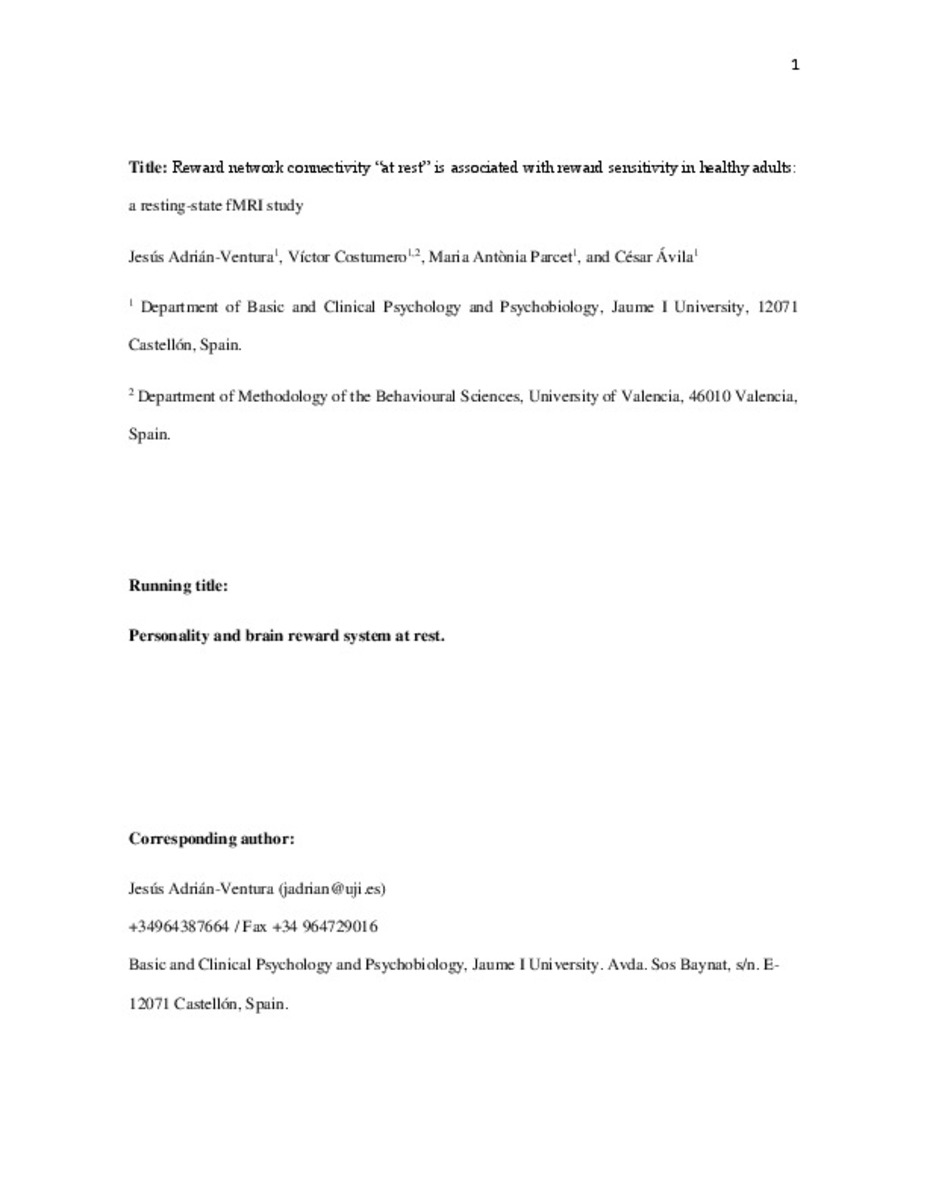Mostrar el registro sencillo del ítem
Reward network connectivity “at rest” is associated with reward sensitivity in healthy adults: A resting-state fMRI study
| dc.contributor.author | Adrián-Ventura, Jesús | |
| dc.contributor.author | Costumero, Víctor | |
| dc.contributor.author | Parcet, Maria Antonia | |
| dc.contributor.author | Avila, Cesar | |
| dc.date.accessioned | 2019-04-11T07:14:34Z | |
| dc.date.available | 2019-04-11T07:14:34Z | |
| dc.date.issued | 2019 | |
| dc.identifier.citation | Adrián-Ventura, J., Costumero, V., Parcet, M.A. et al. Reward network connectivity “at rest” is associated with reward sensitivity in healthy adults: A resting-state fMRI study. Cogn Affect Behav Neurosci 19, 726–736 (2019). https://doi.org/10.3758/s13415-019-00688-1 | ca_CA |
| dc.identifier.issn | 1530-7026 | |
| dc.identifier.issn | 1531-135X | |
| dc.identifier.uri | http://hdl.handle.net/10234/182288 | |
| dc.description | This is a post-peer-review, pre-copyedit version of an article published in Cognitive, Affective, & Behavioral Neuroscience. The final authenticated version is available online at: https://doi.org/10.3758/s13415-019-00688-1. | |
| dc.description.abstract | The behavioral approach system (BAS), based on reinforcement sensitivity theory (RST), is a neurobehavioral system responsible for detecting and promoting motivated behaviors towards appetitive stimuli. Anatomically, the frontostriatal system has been proposed as the core of the BAS, mainly the ventral tegmental area and the ventral striatum and their dopaminergic connections with medial prefrontal structures. The RST also proposes the personality trait of reward sensitivity as a measurable construct of stable individual differences in BAS activity. However, the relationship between this trait and brain connectivity “at rest” has been poorly studied, mainly because previous investigations have focused on studying brain activity under reward-related contingency paradigms. Here, we analyzed the influence of reward sensitivity on the resting-state functional connectivity (rs-FC) between BAS-related areas by correlating the BOLD time series with the scores on the Sensitivity to Reward (SR) scale in a sample of 89 healthy young adults. Rs-FC between regions of interest were all significant. Results also revealed a positive association between SR scores and the rs-FC between the VTA and the ventromedial prefrontal cortex, and between the latter structure and the anterior cingulate cortex. These results suggest that reward sensitivity could be associated with different resting-state activity in the mesocortical pathway. | ca_CA |
| dc.format.extent | 11 p. | ca_CA |
| dc.format.mimetype | application/pdf | ca_CA |
| dc.language.iso | eng | ca_CA |
| dc.publisher | Springer | ca_CA |
| dc.relation.isPartOf | Cognitive, affective & behavioral neuroscience, 2019 | ca_CA |
| dc.rights | © The Psychonomic Society, Inc. | ca_CA |
| dc.rights.uri | http://rightsstatements.org/vocab/InC/1.0/ | * |
| dc.subject | personality | ca_CA |
| dc.subject | reward | ca_CA |
| dc.subject | functional connectivity | ca_CA |
| dc.subject | basal ganglia | ca_CA |
| dc.subject | prefrontal cortex | ca_CA |
| dc.title | Reward network connectivity “at rest” is associated with reward sensitivity in healthy adults: A resting-state fMRI study | ca_CA |
| dc.type | info:eu-repo/semantics/article | ca_CA |
| dc.identifier.doi | https://doi.org/10.3758/s13415-019-00688-1 | |
| dc.relation.projectID | Ministerio de Educación, Cultura y Deporte: FPU15/00825; Secretaría de Estado de Investigación, Desarrollo e Innovación: PSI2016-78805-R; Generalitat Valenciana: PROMETEO/2017/109 | ca_CA |
| dc.rights.accessRights | info:eu-repo/semantics/openAccess | ca_CA |
| dc.relation.publisherVersion | https://link.springer.com/article/10.3758/s13415-019-00688-1 | ca_CA |
| dc.type.version | info:eu-repo/semantics/acceptedVersion | ca_CA |
Ficheros en el ítem
Este ítem aparece en la(s) siguiente(s) colección(ones)
-
PSB_Articles [1310]
Articles de publicacions periòdiques







